Rock Art in Panna - What does it mean to the people who live there?
Rock art is widely found in caves and along shady parts of the rocky Vindhya hills of Central India, where the Panna Tiger Reserve is located. These are truly beautiful paintings, but what is their significance to the present local community?
The mystery of paintings made in blood
A goat herder points towards the distant hills of the Panna Tiger Reserve and announces “You will find Khoon se bana chitre” (paintings made in blood). When I arrive at the spot, I do indeed find the well-preserved rock art and wonder what the paintings mean to locals. What meaning do they construct from these old drawings on stone? If the paintings are important to the people who live here, do they also ensure their preservation? Or are these simply drawings that are forgotten and destined to fade with time?
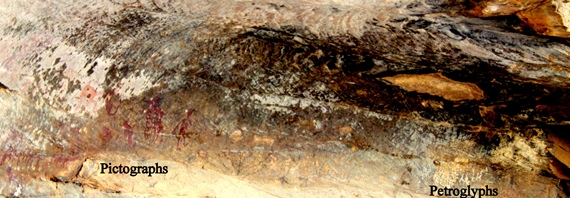
Pictographs (paintings) on the left and petroglyphs (engravings) on the right on shaded rock face. © Kolipaka.S.S
In India little detailed and reliable information on rock art is available: just a few ad hoc brochures and visitor pamphlets near some sites. It is also very difficult to access published literature describing rock art in India. Adding to this difficulty, I found out that interpreting rock art accurately is a highly specialised skill, and pseudo-experts are plentiful. Since areas around Panna were historically ruled by Gond Adivasis (native inhabitants) of Central India, and since remnants of their extinct kingdom are still found in Panna, I wondered whether the rock art of the region might reveal facets of the life of ancient Gond tribes in the area.
Looking at the images, I discovered considerable differences in the way rock art was drawn. The style of drawing and the subjects depicted varied considerably, suggesting that art on rocks may have been practised for a long time and not just restricted to a certain period. At some of the rock art sites relatively new drawings can be seen beside those that look very ancient. I was curious to understand whether local inhabitants still continue the practice of drawing on rock, and what rock art means to them.

Deer with arrows shot into it, hunter and a long horned bovine on the right. © Kolipaka.S.S
Powerful spirits dwelling in the forest
Forest-dwelling villagers of Panna associate rock art with animistic spirits. They see rock art as the work of spirits and not of any living people. Local people believe that powerful spirits inhabit the natural world, and that such spirits have the power to ensure their wellbeing and also to inflict harm. Therefore, they revere them and worship them. People described to me the dozens of different types of spirits they worship. One such spirit is that of their ancestral Gond king “Sabbal Shah”, who is attended by his invincible army of troops on horseback and on foot.
One evening, my guide Asharam, a Gond tribal who was also a local spirit medium and a respected traditional healer, told me about the powerful Sabbal Shah. At full moon, he said, “during the very late hours, Sabbal Shah and his troops move out in procession and one can hear the snorts, squeals, and blowing of horses, the jingling of the bells tied to the horses’ ankles, and the whispers of troops as they talk and march in step”. “They patrol the villages and destroy evil spirits that cast their spells on the villages.”

Maata, the she spirit drawn in black is drawn sitting on a bull. The feet of the bull are drawn as circles,
which are typical to rock art found in Panna. © Kolipaka.S.S
I could see that listeners were fascinated by the narrative, and some ladies shifted position and drew closer to one another. Asharam announced, “There is no reason to fear Sabbal Shah. He and his troops are out on patrol to ensure our safety. However, if a person has bad thoughts in his mind, or if a person schemes against another with intent to harm, Sabbal Shah will punish them.” “Even I cannot save you from his wrath”, he added.
The next morning, I showed Asharam a photograph of a piece of rock art (pictograph below) I had come across in the remote forests of the area; the scene matches every detail of his narrative on King Sabbal Shah and his army. Asharam took a long deep breath and said, “Raja Sabbal Shah”. He turned to me and asked, “Where did you find this Khoon ka Chitre (picture in blood)? I have only heard from my elders that such pictures are found in the forests. It must be a truly special site.” Asharam and fellow villagers explained that if a spirit wants to communicate with a person or with people, an image appears on the rocks. Experienced spirit mediums then look out for such images and interpret their meaning and significance.

Pictograph of people riding animals, Panna Tiger Reserve. © Kolipaka.S.S
Sacred animals
Villagers revere some species of wild animals and domestic animals as sacred religious symbols and also as animals belonging to the spirits. Such animals are considered sacred, and many norms and taboos influence people’s interactions with and attitudes about these species. As one villager said, “If animals that are sacred to the spirits are harmed, spirits will unleash difficulties on offenders”. A remedy in such a case might involve making a valuable offering to the spirits to pacify them. Most villagers view animals painted on rocks as sacred animals and even worship them. The sacred animals include tigers, leopards, cows, nilgai antelopes, monkeys, birds of many varieties, snakes, and even insects like geckos, scorpions, and millipedes.
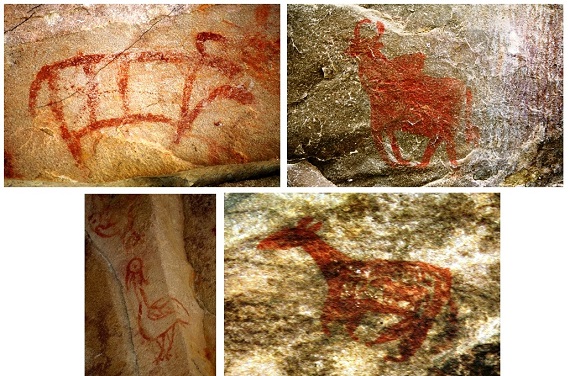
Two bulls, a stork and a nilgai antelope. A young baby in drawn on the stomach area of the antelope,
depicting a pregnant nilgai. © Kolipaka.S.S
Some villagers view rock art as sacred, and as evidence of spirit prophecies. In one drawing, for example, depicting big cats and a hunter (Fig 7), the dotted cats are interpreted as mythical spirit animals (dotted lines), which are beyond the reach of hunters. As my blog on the Panna Tiger Reserve showed, the villagers refuse to accept that tigers can be killed by mortal men, insisting that they are spirits and thus indestructible. They feel that if tigers become extinct in a forest, that forest has lost its spiritual character.
In a rural area such as Panna, where traditions and traditional ways of life still prevail, rock art has relevance even today. For many forest-dwelling people in Panna rock art is spiritual, it is religious , and it is interpretable. It helps maintain a sense of continuity between the present (the living) and the past (the dead), and also constitutes a link between the living world and the spiritual world.
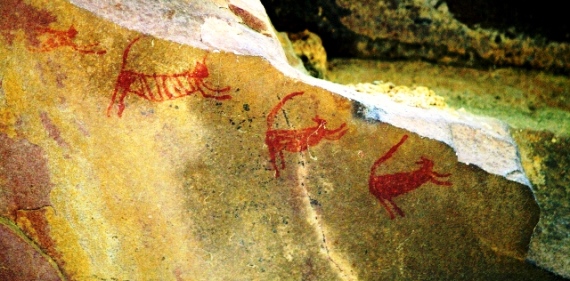
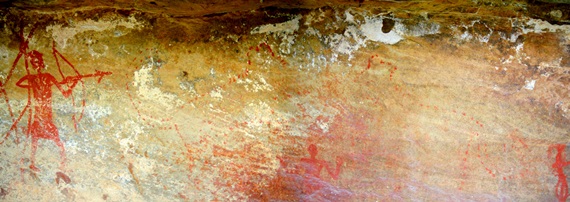
Above: Tiger chasing langur monkeys. Below: A hunter with his bow and arrow
and the two dotted outlines of tigers. © Kolipaka.S.S


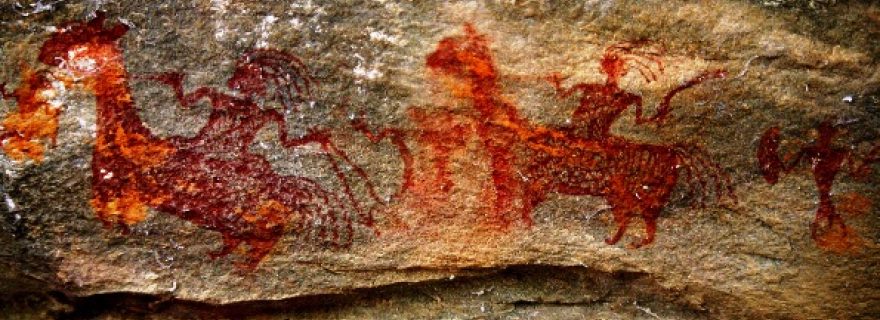
6 Comments
please contact me if anyone trying to explore/document the rock paintings of Vidhya mountains range falling in between from chitrakoot to Panna. I have all details about them. My contact no. is 7007960475
Dear Mr Kolipaka,
I'm very interested in your artcle about Rock Art in Panna.
I have already been in the Panna Tiger Reserve, and will probably go back this year, in October or November.
Is it possible to visit the caves? Are there guides? I would like to have more information about it. Can you give me the references of a conatct person?
Thanks,
Arlette Boeckstyns
aboeckstyns@mail.be
Dear Sir,
Please have a look on papers concerning Indian Rock Art, in ROTSKUNST.nl
author Bert Schaap Studiecentrum voor Prehistorische Kunst, Maastricht.
I'am a member of RASI and editorial advisor of PURAKALA, Agra.
Kind regards
Bert Schaap
Studiecentrum voor Prehistorische Kunst,
Moesdaal 27B,
6228HX Maastricht
E-mail centrumprehistorischekunst@ziggo.nl
Dear Mr Shekhar Kolipaka,
You have given a good account of varied details including local narratives given by the Guide and what other locals believe about these rock art.
As they say, "Khoon ka chitre"; I personally feel because these are in indifferently red in color they consider it to have been made in blood..!! But, it is good as they consider them to be of religious and spiritual importance. It is for this the paintings are nearly intact. What about petroglyphs? What kind work is executed there? I could not have feel/ understand them. What sort figurative/ geomatrics/ Cupules etc are executed there? Please do communicate.. I shall be thankfully obliged.. For paintings you have gone in great detail. You have done a great job. Congratulations. Please stay in contact my contact mob. +91 99531 21626.
Mr. Satish Jain,
The rock art in Panna varies from 3200 years old to current.
If you have more question please contact me via email.
Glad you went to Panna.
Dear Mr. Shekhar Kolipaka !
You did a commendable job / studying the rock art of PTR.
I was really keen , rather was dying ,to know more and more
about these paintings .
What is your estimation of range of period ,these might have been created ?
I recently , on 21st March 2017 visited the Sanctuary and rock paintings as well .
Only curious and adventurous people like you can do such work .
09319304212 Meerut . Please share your contact
Add a comment